8 years! A full 8 years! I have endured in the crucible of the cryptocurrency world, what I have burned away is not only savings but also hope! In the first three years, my account crumbled like a dam infested with worms, collapsing over 100 times! Those nights of hardship, those teeth ground to dust, those heart-wrenching screams in front of the trading records... have all become marks engraved in my heart.
In the last four years, the market has become my ATM! Hundreds of coins flow in easily. Don't ask about luck; this market only recognizes two points: deep understanding and strict discipline!

I later used low-risk trading strategies to quickly earn 4 million from an initial capital of 10,000. 'Average trader Bitcoin': Over three years, the trading strategy went from over 1 million to several thousand. My current gains involve a trading strategy—rolling position.
Steps for rolling position operation.
1. Choose a target: Select a cryptocurrency that you believe will rise in the future.
2. Initial purchase: Use all your funds to buy this cryptocurrency.
3. Set a stop-loss: Set a stop-loss below the purchase price to limit your losses.
4. Monitor the market: Continuously monitor market trends.
5. When the price rises: If the price rises to the preset target, use part of the profits to increase your position and buy more.
6. Repeat steps 4 and 5: Continue to monitor the market and increase your position when the price rises.
Many people think rolling position is risky, but compared to opening futures positions, the risk is actually more controllable.
The following will be taught from a practical perspective⬇️
2/
Understanding rolling position through examples.
Review of Bitcoin's bull market from 2020 to 2021. From October 2020 to March 2021, Bitcoin rose from 10,000 to 60,000. We will use this market as an example to review how rolling position operations can promote rapid capital growth.
This is a unilateral upward trend during a bull market; we will review the rolling position operations during this time, focusing on how to effectively implement rolling positions to achieve rapid compound growth of capital.
First entry (Figure 1)
At the candlestick located at the arrow position in the diagram below, we can see that after a period of medium to long-term fluctuations, Bitcoin formed a converging triangle structure. At this position, a large bullish candle broke upward through the downward trend line, sending us a bullish signal.

A large bullish candle breaks through the right side of the converging triangle, sending a bullish signal.
Thus, at the position indicated by arrow 1, when BTC issued a right-side bullish signal, we can track the right-side breakout, assuming we opened a long BTC position.
Second entry (Figure 2)
The subsequent market entered a very strong upward trend. At the position pointed to by the mouse, it can be seen that Bitcoin formed an upward triangle converging pattern.
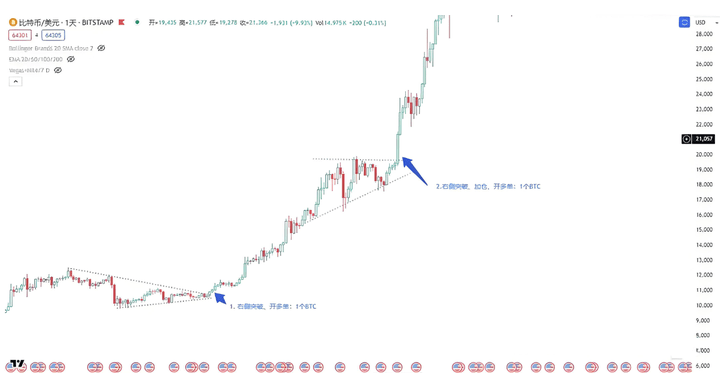
(Figure 3) At this position, it is precisely the right timing defined by the average trader, which is the timing for rolling position, located at the place indicated by arrow 2. If we execute a right-side chasing breakout here and open a long BTC position, we can see that Bitcoin broke through the previous high with a large bullish candle after several medium to long-term fluctuations. This position meets the three key strategies of the average trader: right-side trading, chasing breakouts, and increasing positions based on unrealized profits.
Additionally, at the point where the convergence triangle formed at the position indicated by arrow 2, there was also an opportunity to increase positions, which is the place indicated by arrow 3.
We can regard it as the support point of the ascending trend line. At this position, according to the average trader's defined strategy, increasing positions during a pullback is feasible. When the price falls near the ascending trend line and closes a small real body candlestick, followed by a large bullish candle, this is also an opportunity to increase positions and is part of the rolling position process.
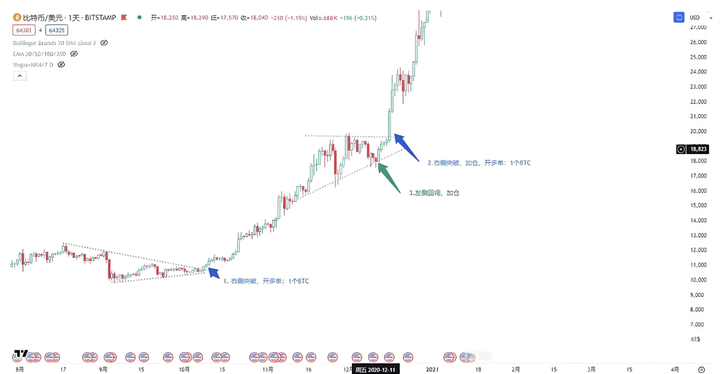
(Figure 4) It should be noted that the position indicated by arrow 3 belongs to relatively left-side trading. Left-side trading carries higher risks, but the risk-reward ratio for entry is better. Compared to the first position, the second position is an unrealized profit increase (also known as rolling position). It can be seen that the market then experienced a strong upward trend, and by January 2021, Bitcoin's price reached about $40,000, then a significant pullback occurred, followed by the emergence of a converging triangle structure.
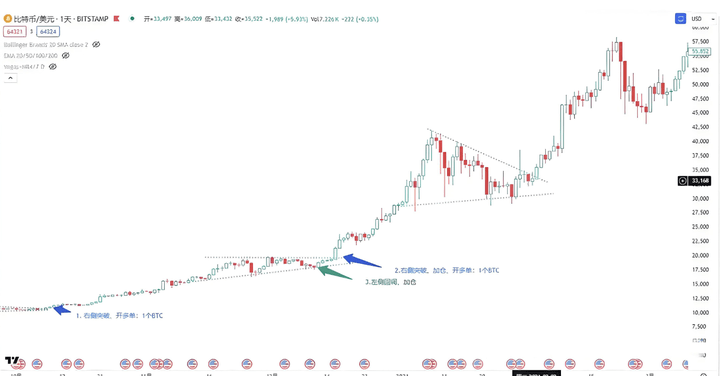
3/
(Figure 1) Looking back at our previous two entries, assuming our candlestick has evolved to a position before a significant pullback, the price is approximately 40518. At this time, we can see that the unrealized profit increase (rolling position) at point 2 has risen by 101%.
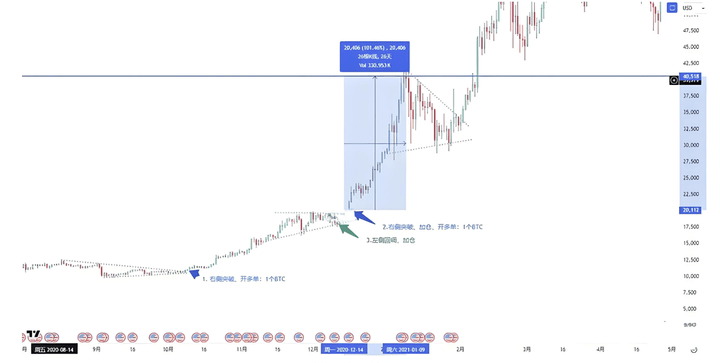
(Figure 2) If the long position at the initial point 1 is held until this position, its increase is 261%.
After completing the rolling position operation, the long trade at position 2 has already captured the subsequent main upward wave. When the price reaches a phase-resistant position, you can quickly reduce this portion of the position. That is, you can directly close the long BTC position at the pullback position of 40518.
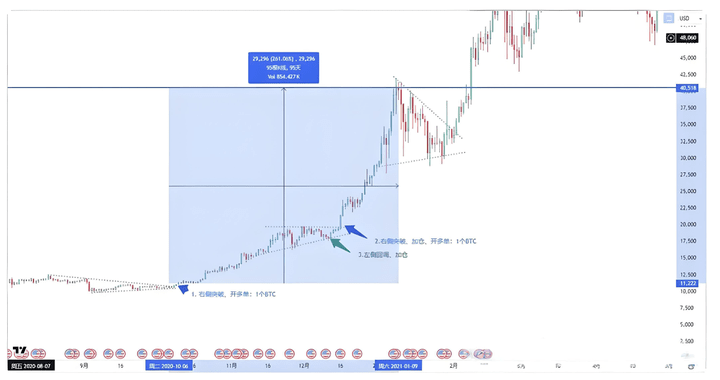
4/
Third increase opportunity
Looking back from the price of 40518, we will find that there were also opportunities for rolling position later. As shown, point 4 is a position for right-side chasing breakout, suitable for rolling position. Similarly, point 5 is a position for left-side pullback increase (similar to previous point 3, left-side increases have a better risk-reward ratio).
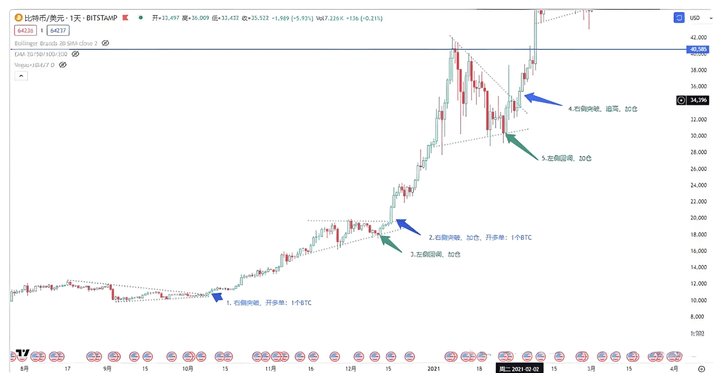
Rolling position operations at points 3 and 5 using left-side trading strategies test the trader's technical level more.
When buying at low points or moving averages, more indicators or strategy signals must be combined to serve as the basis for trading.
For example: We can open a daily chart's mid-term moving average, MA30. At position 3, we can see it at the support level of the first fluctuating triangle, and a bullish candle appears while staying above the daily MA30. Therefore, this position can serve as a basis for judgment.
For instance, at position 5, if we open the Fibonacci retracement of the previous upward trend, we can see that the low of the candle at position 5 basically retraced to the 0.5 level of the previous upward trend. This means that once the upward trend is established, the secondary pullback to 0.5 or even the extreme 0.618 is very important. After closing a bullish candle here, position 5 can also be regarded as a suitable position for rolling position.
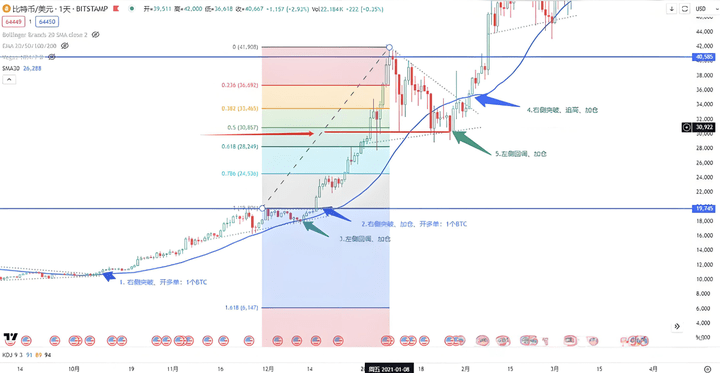
Next, at position 6, we can see a large bullish candle broke through the previous high, making it a suitable position for rolling position.
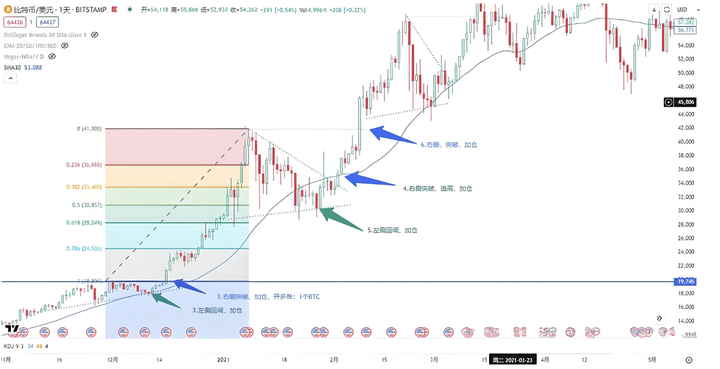
Subsequently, the market came to position 7.
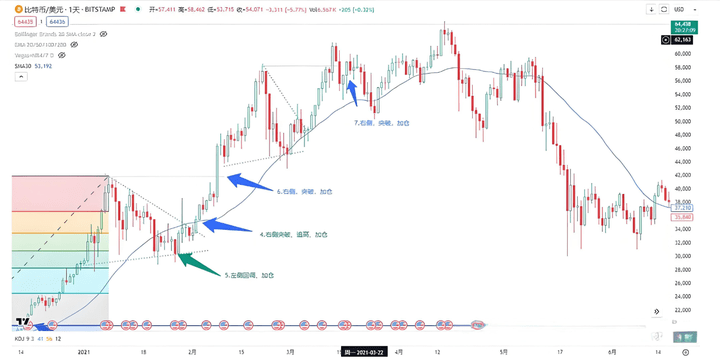
On this day, a large bullish candle broke through the previous high. Therefore, at position 7, we can use it as a basis for right-side trading to execute a rolling position.
After a large bullish candle closes, chasing the breakout is a reasonable choice. However, we later see that the breakout at position 7 was actually a false breakout. If rolling position was executed at position 7, subsequent signals indicate that this action was a failure. Even if a high point was formed and broke out again after position 7, it then fell again, which is also a false breakout.
Therefore, if we execute a rolling position at position 7 and subsequent signals, this rolling position operation failed.
5/
Suppose you only have 50,000, how can you use this money to start your investment journey?
First of all, this 50,000 should be your profit. If you are still in a loss, then do not rush to look further.
If you buy Bitcoin at a price of 10,000 and set 10 times leverage, using the isolated position mode to only open 10% of the position, that is, only using 5,000 as margin. This is equivalent to using 1 time leverage, setting a 2% stop-loss, even if the stop-loss is triggered, you will only lose 2%, which is 1,000. How do those who blow up their accounts do it? Even if you blow up your account, you only lost 5,000, how could you lose everything?
If you guessed correctly and Bitcoin rose to 11,000, continuing to open 10% of the position with a 2% stop-loss, even if the stop-loss is triggered, you still earn 8%.
What about the risks? Isn't the risk very high?
Following this logic...
If Bitcoin rises to 15,000 and you keep increasing your position, capturing this 50% market movement, you should be able to earn around 200,000. By capturing two such movements, your account could grow to around 1 million.
There is no need for compound interest; a 100-fold increase comes from two 10-fold increases, three 5-fold increases, or four 3-fold increases, not from achieving 10% or 20% returns every day or month. That is just nonsense.
Rolling position is not suitable for all cryptocurrencies. Choosing cryptocurrencies with good liquidity and active trading can reduce risks. Do not over-leverage, as it can easily lead to liquidation. Setting stop-loss and take-profit levels can help you control risks and lock in profits.
Remain calm during market fluctuations; do not make impulsive decisions. If market fluctuations are severe, rolling position is not suitable, as it is easy to be swayed by emotions and make incorrect decisions.
6/
How to avoid risks in rolling position?
The previous increases went smoothly, but in reality, it may not always be so smooth. Let us look back at the first two trades.
1. Initial entry: At position 1, we executed right-side chasing and opened a long BTC position.
2. Increase positions: At position 2, we also increased positions while breaking through the right side, opening another long BTC position.
After completing the trades at positions 1 and 2, our average cost has risen, approximately located between positions 1 and 2. It can be seen that after breaking through position 2, the market indeed entered an upward trend. However, after increasing the position at position 2, the market may not continue to rise, but instead form a reversal pattern; this is completely reasonable, and we cannot accurately predict market trends.
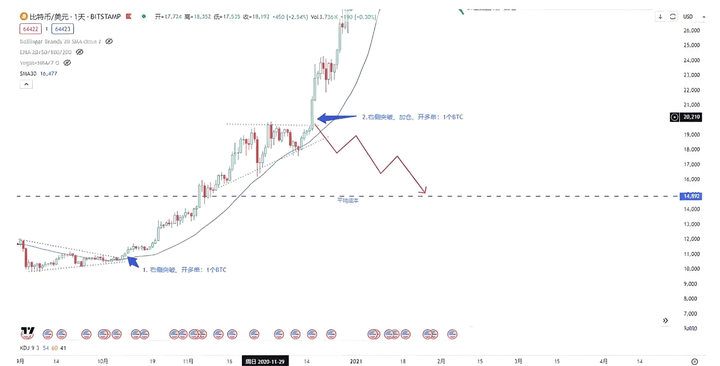
When this situation occurs, we will encounter profit drawdown. The trade at position 1 was profitable, but after increasing the position at position 2, the risk increased, leading to a profit drawdown when the price fell. If the price drops below the average cost of our two trades, the profit drawdown will turn into a loss.
Trailing stop-loss
By executing rolling position operations, while releasing profits, our risks also increase. To control risks after rolling position operations, it is essential to implement trailing stop-loss strategies. Beginners can refer to volatility indicators such as ATR (Average True Range), while veterans can use technical indicators, price actions, etc., to find favorable stop-loss points.
For example, after rolling position at position 2, we can set the stop-loss for the newly added position below the related trailing stop-loss curve of the ATR volatility indicator.
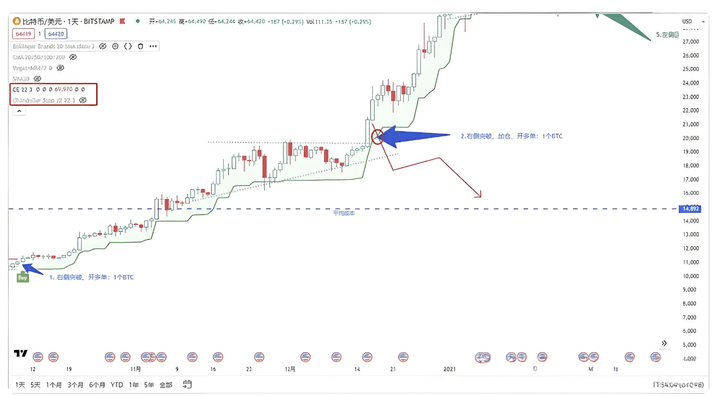
The specific operation is: open a long BTC position at position 2. If this is a false breakout, meaning it breaks out and then falls back, we can reduce this newly increased position based on the trailing stop-loss curve provided. In this way, even if the rolling position fails, we can at least reduce the newly added position to minimize losses.
7/
The drawbacks of rolling position.
Through the above simple examples, I believe everyone should understand the definition of rolling position, which is increasing positions based on profits and identifying suitable locations for rolling positions, such as at breakout points or lows of secondary pullbacks.
Some people may think that rolling position is so simple that making money must be too easy.
Actually, it is not the case. We are just clarifying this concept through a simple example. In reality, rolling position requires a very high overall quality from traders. Rolling position is only suitable for unilateral trend markets, that is, after increasing the position, the price continues to rise and rises again after a pullback.
In fact, 90% of market conditions are fluctuating. In this case, if you keep increasing your position, you will only continue to lose. For example, if you rolled position in the fluctuating market over the past four months, you would also continuously lose. Unless you have a large amount of capital, you will lose all your funds.
Therefore, rolling position is only suitable in approximately 10% unilateral trend markets. Additionally, rolling position must be combined with very strict and scientific trailing stop-loss; otherwise, overall risk will be very high.
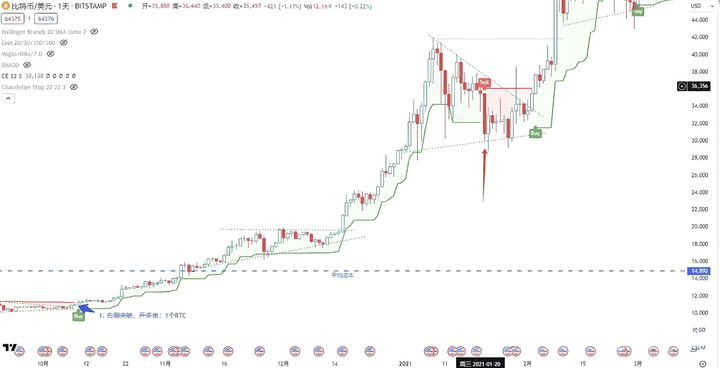
After the stop-loss on this trade on 2021-01-20, the average trader chose to stop trading. Looking back, his withdrawal was very wise and insightful. This is the average trader's style: no particularly amazing operations, but such a system can bring long-term huge returns.
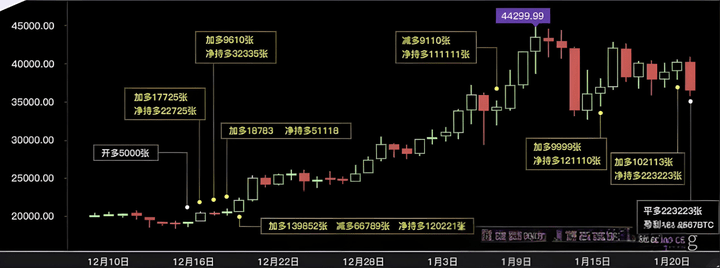
Summary of the average trader's rolling position trading records.
However, from the average trader's overall trading records, his overall winning rate is very low, for the following three reasons:
1. Breakout trading: The average trader focuses on breakout trading, while most breakouts fail. Nevertheless, he still engages in breakout trading because the losses from failed breakouts are small, possibly only losing 1% to 2% of capital. But if the breakout is successful, his account may double or more, thus achieving a very high risk-reward ratio that can reach dozens of times. Even if breakouts are likely to fail, this risk-reward ratio still makes him willing to try.
2. Focus on the big trend: The average trader only captures big trends, and many times even when earning decent profits, they do not exit. Their goal is to capture the big trend, which leads to a lower winning rate. If they focus on capturing small trends, their winning rate would be much higher, but they would not achieve the same results. They calmly accept a low winning rate because their goal is the huge returns brought by the big trend.
3. Do not accept missing out: The average trader does not want to miss any big trend. On the premise of not accepting missing out, they continuously try to enter whenever there is a breakout signal. Only in this way can they ensure that once the trend starts to run, they are definitely in the market, capturing the profits brought by the big trend.
The average trader's method emphasizes risk management, adhering to breakout trading, focusing on big trends, and ensuring that every potential big trend is captured through constant attempts. Although the winning rate is low, their high risk-reward ratio and clear strategy have allowed them to achieve very exaggerated returns in the long term.
8/
Rolling position and pyramid adding.
If you are interested in rolling positions, you should also understand pyramid adding.
Pyramid adding and rolling position are common strategies in trading; you can understand pyramid adding as a more conservative form of rolling position, as they share many similarities.
Location:
> Trend following: Both increase positions when market trends are clear, using the profit opportunities brought by trends.
> Gradually increasing positions: not adding full positions at once, but gradually increasing positions based on market trends.
> Unrealized profit basics: The basis for increasing positions is built on existing unrealized profits, not on adding positions when losing.
The pyramid adding method is a technique that can increase profits exponentially, essentially adding positions in the direction of the trend based on existing profits to seek future gains, a high-level trading technique.
It is only suitable for strong unilateral markets, which can be rapid upward trends or rapid downward trends. As shown in the image below, we can clearly see the steps of pyramid adding.
The pyramid adding method is a gradual trend-following increase, but it is definitely not the 'averaging down' method used by many stock traders. The most direct difference is:
> We do not increase positions when losing—counter-trend adding is the cause of serious losses for many people, even leading to many people 'blowing up' their accounts.
> The pyramid adding method and rolling position (increasing positions based on unrealized profits) are very similar, with the main difference being that the added positions in pyramid adding decrease in proportion as you go further.
The longer the trend runs, the more likely there will be adverse reversal trends, and psychological pressure gradually increases. Using a pyramid adding method is more conservative; comparing pyramid adding with rolling position:
> Gradually reducing the amount of increase: total positions grow slowly, even if the market reverses, total losses are kept within a smaller range.
> Each time increasing the same position: total positions grow rapidly, and even slight adverse market fluctuations can lead to significant losses, posing high risks.
Practical suggestions for rolling position strategy.
Rolling position techniques are not complicated, but their high risk and high returns determine that this is a strategy for professional veterans, especially suitable for unilateral trend markets. The core of rolling position lies in position management and trend judgment, thus requiring a combination of scientific capital management and trailing stop-loss strategies. The following framework will detail the practical steps of rolling position strategy, helping you capture trends in the market and steadily increase your position.
Basic knowledge and preparation
Basic understanding of leveraged trading.
In rolling positions, the use of leverage can amplify profits, but it also carries enormous risks. Therefore, it is recommended to use leverage under isolated position mode to avoid the risks of full-position operations. Full-position operations carry extremely high risks and are especially unsuitable in rolling position strategies. Set your trading goals.
The goal of rolling position is to achieve compound growth through increasing positions, but this only applies to unilateral markets. In most markets (90% fluctuating markets), rolling position strategies are not applicable, so we need to have enough patience to wait for clearly trending markets. Setting a goal of doubling small capital can help you stay focused, but more importantly, wait for the timing after confirming the trend.
Technical indicator selection: To accurately judge trends, the following indicators can help you find the best timing for rolling position.
> MA (moving average): The main tool for judging major trends and pullbacks.
> MACD: To confirm trend strength and potential reversal signals.
> Converging triangle: A common fluctuating pattern; when it breaks out, it may signal the start of a trend.
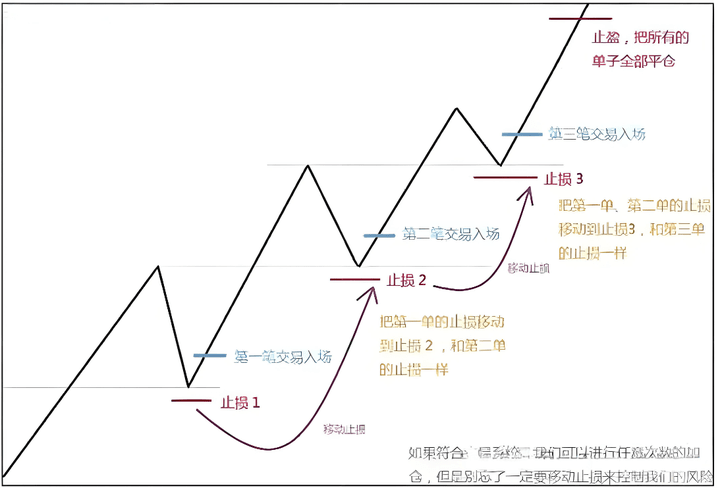
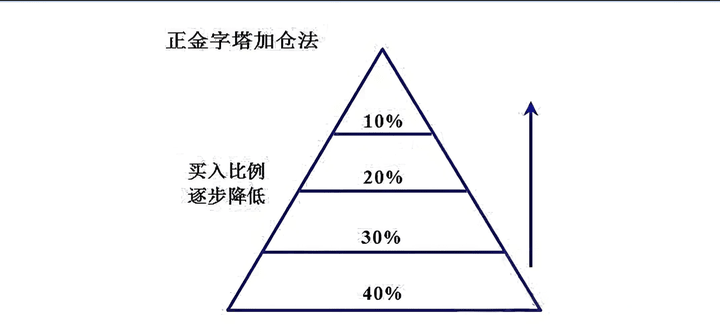
9/
The core strategy of rolling position.
Applicable conditions: Unilateral markets.
The core applicable condition for rolling position strategy is unilateral markets, that is, clear trending markets. In fluctuating markets, rolling position strategies may cause you to frequently stop-loss or even incur losses. Therefore, you must wait for clear trend signals in the market, such as breakthroughs after prolonged sideways movement, to be suitable for rolling position operations.
Mindset and timing
Rolling position not only tests your technical analysis ability but also tests your mindset. Facing opportunities with huge profit potential, you must have enough patience to wait for high-certainty moments. Rolling position is not suitable for frequent operations. We only increase positions in confirmed trending opportunities, such as breaking through long-term resistance levels or unilateral markets after fluctuating patterns.
Core logic: Position management and trend judgment
The core of rolling position lies in position management and trend judgment. When judging trends, you need to distinguish between true and false breakouts, identify when there is a pullback, and when a trend reversal occurs. This not only requires technical analysis skills but also strict capital management and trailing stop-loss strategies. After each increase in position, move the stop-loss up to ensure that unrealized profits are not consumed by market fluctuations.
Timing and ratio of increasing positions
The timing for increasing positions in rolling position is critical. Typically, increase positions in the direction of the trend after breaking through trend lines or inversely increase positions when the trend pulls back to the moving average. The capital for each increase should be pyramid-shaped; as the number of increases increases, the proportion of increases should gradually decrease to avoid excessive risks from subsequent increases.
Practical steps
Step 1: Initial entry.
Establishing positions at breakout points that have undergone sufficient fluctuations, such as breaking through important resistance levels. Initial positions should be controlled at 10%-20% of total capital to mitigate significant market fluctuations. At this time, setting stop-loss levels is usually 2%-3% below key support levels.
Step 2: Trend-following increases.
When the initial position shows unrealized profits, you can choose to increase your position at the next pullback or breakout point. Usually, when the price pulls back near the moving average and rebounds, or after breaking through, it can serve as a signal to increase positions. The capital proportion for each increase should not be too large, generally recommended not to exceed 30% of the original position.
Step 3: Risk control and take-profit strategy.
Risk control in rolling position strategy is particularly important. As each position increases, you need to use trailing stop-loss, gradually moving the stop-loss to the previous increase point to ensure that unrealized profit parts are not consumed by market fluctuations. When reversal signals appear, timely reduce positions or close positions to avoid significant drawdowns.
Step 4: Accumulating compound interest.
After each successful rolling position, you can continue to invest the unrealized profit portion for increasing positions, forming compound growth. However, avoid frequent operations; rolling position is suitable for medium to long-term trends, not short-term frequent increases. The goal of rolling position is to continuously expand positions with the continuation of trend markets, maximizing returns.
Trading frequency
Rolling position operations are suitable for execution when breaking through significant resistance and support levels on daily or weekly charts, rather than frequent short-term trading. Frequent position increases in fluctuating markets carry significant risks and may lead to substantial losses.
Although the rolling position strategy can amplify profits, the essence of increasing positions based on unrealized profits is that it increases leverage and risk. Therefore, it is recommended to adopt a pyramid model when increasing positions, with smaller increases as you go further. When profits are significant, consider gradually reducing positions rather than continuing to increase them.
Capital and stop-loss management.
In rolling position strategy, scientific capital management and trailing stop-loss strategies are key. If the stop-loss position is not adjusted in time after increasing the position, it may lead to unrealized profits turning into losses. Before each increase in position, be sure to set the specific position and trailing stop-loss strategy in advance.
10/
Common questions and answers
Is rolling position suitable for beginners?
The rolling position strategy carries significant risks, and it is recommended that beginners start with low leverage and stable trend trading, accumulating experience before considering using rolling positions.
How to determine the timing for increasing positions?
The timing for increasing positions usually occurs after breaking through key points in the trend or rebounding to support levels during pullbacks. Technical indicators such as moving averages, MACD, and converging triangles can assist in judgment.
How to operate in a fluctuating market?
Rolling position is not suitable for fluctuating markets; when encountering fluctuating markets, one should reduce operational frequency and patiently wait for trends to emerge.
Can we roll position directly when opening a position?
Whether to roll position directly when opening a position or to wait until there is a profit before using the profit portion to increase position depends on your trading strategy and market conditions. The core idea of rolling position is to continuously increase the position in trending markets, using unrealized profits to increase position for compound growth. Therefore, under normal circumstances, rolling position is conducted on the basis of existing profits, allowing the market's already earned money to bear the risks of new positions, thereby reducing personal capital risk exposure.
Here are two common methods for rolling position:
Open positions and roll positions after confirming the trend: After confirming the trend, open positions, and then gradually expand positions through rolling positions as the trend develops. This method utilizes the power of the trend to roll positions based on unrealized profits, aiming for higher returns. A typical practice is to open positions after breaking through key positions and gradually increase positions once there is a profit. The risk at this point is low because the subsequent increase in positions uses profit funds.
Rolling position immediately upon opening a position: In some strategies, traders immediately implement rolling position upon opening a position, usually relying on considerable capital leverage. This method carries high risks because there is no profit buffer initially, and directly increasing positions may lead to higher losses. It is suitable for very experienced traders when the trend is extremely clear.
The rolling position discussed in this article tends to utilize profits for increasing positions, as emphasized by the average trader and others, through increasing positions based on unrealized profits in trends and controlling risks through stop-loss mechanisms. Therefore, it is generally recommended to wait until the position has a certain profit before using rolling position strategies to reduce risks and effectively amplify profits.
Final suggestions
I would like to offer some suggestions to beginners or friends who want to imitate this approach.
1. Lower risk-reward ratio:
Beginners may find it hard to endure prolonged unrealized losses and frequent stop-losses to capture big trends, often losing all their capital or breaking down psychologically before a big trend occurs. Therefore, I suggest beginners lower their risk-reward ratios but not too low. Generally, the risk-reward ratio can be set at around 2 to 3 times. The specific risk-reward ratio should be adjusted according to market conditions. If the market is suitable for 2 or 3 times ratio, use those; if the market is particularly good, boldly try for 4 times or even 5 times. This way, the winning rate can approach 50%, between 45% and 55%, making it easier to maintain a good mindset. For someone like the average trader with a 20% winning rate, it is difficult for most people to persist. If pursuing a 10-fold or even 20-fold risk-reward ratio, one must endure prolonged stop-losses and unrealized losses.
2. Accept missing out:
Not wanting to miss out on any market movements and trying to capture every major movement will inevitably sacrifice the winning rate. Beginners should calmly accept missing out, sacrificing a part of the opportunities to capture a more certain portion. For example, if there are 10 market movements in a year, capturing 2 to 3 of them is sufficient, yielding decent profits and a smoother profit curve without too many stop-losses.
Focus on market context rather than technical details: Instead of delving into numerous technical books and videos, learn to judge the market context. Invest more effort during favorable market conditions and observe during unfavorable ones, only making easy profits. This is crucial. The operations of the average trader are very simple; most of their profits come from the last two trades. If they do not persist in executing, they would have given up long ago and would not have such results. Therefore, it is easier to make money in favorable markets, while continuous trading in unfavorable markets will not yield profits. For example, in 2022, most people found it difficult to profit, so in bad markets, one should rest while in good markets, one should trade more to make more money.
No matter how diligent a fisherman is, he will not go out to sea to fish during the stormy season but will carefully guard his fishing boat, knowing that this season will pass, and sunny days will come! Follow me, and I will teach you how to fish and also how to fish; the door of the cryptocurrency world is always open, only by following the trend can one achieve a life in flow. Save this and keep it in mind!